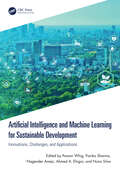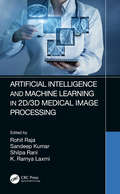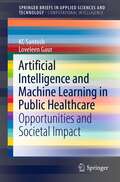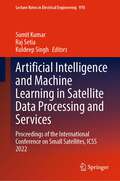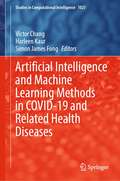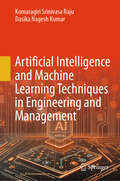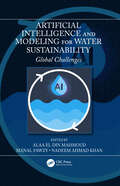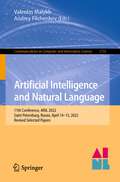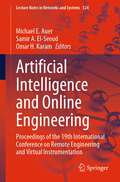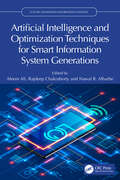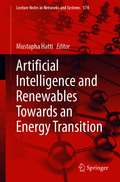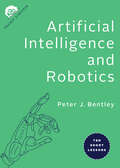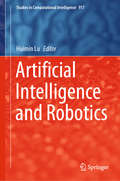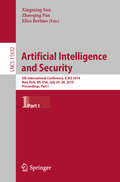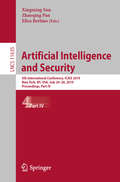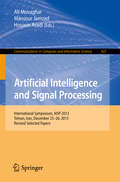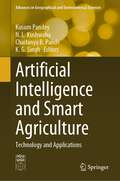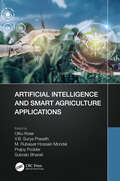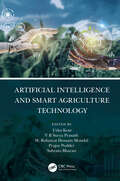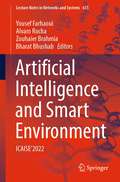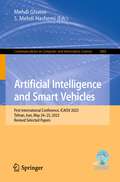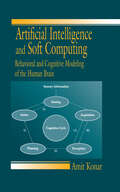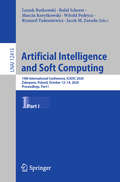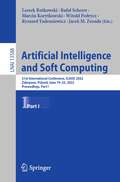- Table View
- List View
Artificial Intelligence and Machine Learning for Sustainable Development: Innovations, Challenges, and Applications
by Pawan Whig Pavika Sharma Nagender Aneja Ahmed A. Elngar Nuno SilvaArtificial Intelligence and Machine Learning for Sustainable Development is a comprehensive exploration of how artificial intelligence (AI) and machine learning (ML) technologies are revolutionizing the field of sustainable development.The book examines cutting-edge innovations, practical applications, and potential challenges in harnessing AI and ML to address global sustainability issues. It offers insights into how these technologies can optimize resource management, improve environmental monitoring, enhance decision-making processes, and promote equitable, eco-friendly solutions. This book would be of special interest to researchers, policymakers, and practitioners seeking to leverage cutting-edge technology for a more sustainable future.
Artificial Intelligence and Machine Learning in 2D/3D Medical Image Processing
by Rohit Raja Sandeep Kumar Shilpa Rani K. Ramya LaxmiDigital images have several benefits, such as faster and inexpensive processing cost, easy storage and communication, immediate quality assessment, multiple copying while preserving quality, swift and economical reproduction, and adaptable manipulation. Digital medical images play a vital role in everyday life. Medical imaging is the process of producing visible images of inner structures of the body for scientific and medical study and treatment as well as a view of the function of interior tissues. This process pursues disorder identification and management. Medical imaging in 2D and 3D includes many techniques and operations such as image gaining, storage, presentation, and communication. The 2D and 3D images can be processed in multiple dimensions. Depending on the requirement of a specific problem, one must identify various features of 2D or 3D images while applying suitable algorithms. These image processing techniques began in the 1960s and were used in such fields as space, clinical purposes, the arts, and television image improvement. In the 1970s, with the development of computer systems, the cost of image processing was reduced and processes became faster. In the 2000s, image processing became quicker, inexpensive, and simpler. In the 2020s, image processing has become a more accurate, more efficient, and self-learning technology. This book highlights the framework of the robust and novel methods for medical image processing techniques in 2D and 3D. The chapters explore existing and emerging image challenges and opportunities in the medical field using various medical image processing techniques. The book discusses real-time applications for artificial intelligence and machine learning in medical image processing. The authors also discuss implementation strategies and future research directions for the design and application requirements of these systems. This book will benefit researchers in the medical image processing field as well as those looking to promote the mutual understanding of researchers within different disciplines that incorporate AI and machine learning. FEATURES Highlights the framework of robust and novel methods for medical image processing techniques Discusses implementation strategies and future research directions for the design and application requirements of medical imaging Examines real-time application needs Explores existing and emerging image challenges and opportunities in the medical field
Artificial Intelligence and Machine Learning in Public Healthcare: Opportunities and Societal Impact (SpringerBriefs in Applied Sciences and Technology)
by KC Santosh Loveleen GaurThis book discusses and evaluates AI and machine learning (ML) algorithms in dealing with challenges that are primarily related to public health. It also helps find ways in which we can measure possible consequences and societal impacts by taking the following factors into account: open public health issues and common AI solutions (with multiple case studies, such as TB and SARS: COVID-19), AI in sustainable health care, AI in precision medicine and data privacy issues. Public health requires special attention as it drives economy and education system. COVID-19 is an example—a truly infectious disease outbreak. The vision of WHO is to create public health services that can deal with abovementioned crucial challenges by focusing on the following elements: health protection, disease prevention and health promotion. For these issues, in the big data analytics era, AI and ML tools/techniques have potential to improve public health (e.g., existing healthcare solutions and wellness services). In other words, they have proved to be valuable tools not only to analyze/diagnose pathology but also to accelerate decision-making procedure especially when we consider resource-constrained regions.
Artificial Intelligence and Machine Learning in Satellite Data Processing and Services: Proceedings of the International Conference on Small Satellites, ICSS 2022 (Lecture Notes in Electrical Engineering #970)
by Sumit Kumar Kuldeep Singh Raj SetiaThis book, Artificial Intelligence and Machine Learning in Satellite: Data Processing and Services, presents the selected proceedings of the International Conference on Small Satellites (ICSS 2022) that aims to provide an opportunity for academicians, scientists, researchers, and industry experts, engaged in teaching, research, and development on satellite data processing and its services by employing advanced artificial intelligence-based machine learning techniques. This book covers the application of artificial intelligence and machine learning techniques in various domains of earth observations like natural resources and environmental management, water resources, urban and rural development, climate change, and other contemporary subjects. The book will surely be a valuable asset for beginners, researchers, and professionals working in satellite data processing and services using artificial intelligence and machine learning approaches.
Artificial Intelligence and Machine Learning in the Thermal Spray Industry: Practices, Implementation, and Challenges (Multi-Scale and Multi-Functional Materials)
by Lalit Thakur Hitesh Vasudev Jashanpreet Singh Gaurav PrasharThis book details the emerging area of the induction of expert systems in thermal spray technology, replacing traditional parametric optimization methods like numerical modeling and simulation. It promotes, enlightens, and hastens the digital transformation of the surface engineering industry by discussing the contribution of expert systems like Machine Learning (ML) and Artificial Intelligence (AI) toward achieving durable Thermal Spray (TS) coatings. Artificial Intelligence and Machine Learning in the Thermal Spray Industry: Practices, Implementation, and Challenges highlights how AI and ML techniques are used in the TS industry. It sheds light on AI’s versatility, revealing its applicability in solving problems related to conventional simulation and numeric modeling techniques. This book combines automated technologies with expert machines to show several advantages, including decreased error and greater accuracy in judgment, and prediction, enhanced efficiency, reduced time consumption, and lower costs. Specific barriers preventing AI’s successful implementation in the TS industry are also discussed. This book also looks at how training and validating more models with microstructural features of deposited coating will be the center point to grooming this technology in the future. Lastly, this book thoroughly analyzes the digital technologies available for modeling and achieving high-performance coatings, including giving AI-related models like Artificial Neural Networks (ANN) and Convolutional Neural Networks (CNN) more attention. This reference book is directed toward professors, students, practitioners, and researchers of higher education institutions working in the fields that deal with the application of AI and ML technology.
Artificial Intelligence and Machine Learning Methods in COVID-19 and Related Health Diseases (Studies in Computational Intelligence #1023)
by Victor Chang Harleen Kaur Simon James FongThis Springer book provides a perfect platform to submit chapters that discuss the prospective developments and innovative ideas in artificial intelligence and machine learning techniques in the diagnosis of COVID-19. COVID-19 is a huge challenge to humanity and the medical sciences. So far as of today, we have been unable to find a medical solution (Vaccine). However, globally, we are still managing the use of technology for our work, communications, analytics, and predictions with the use of advancement in data science, communication technologies (5G & Internet), and AI. Therefore, we might be able to continue and live safely with the use of research in advancements in data science, AI, machine learning, mobile apps, etc., until we can find a medical solution such as a vaccine. We have selected eleven chapters after the vigorous review process. Each chapter has demonstrated the research contributions and research novelty. Each group of authors must fulfill strict requirements.
Artificial Intelligence and Machine Learning Techniques in Engineering and Management
by Komaragiri Srinivasa Raju Dasika Nagesh KumarThe present book covers various facets of Artificial Intelligence, Machine Learning, and Fuzzy Logic. It includes a brief discussion on performance indicators, Classical and Advanced Machine Learning algorithms, Fuzzy logic-based modelling algorithms, Emerging Research Areas, including Blockchain, recent ML techniques, Evolutionary Algorithms, Large Language Model (LLM)-based Generative AI, the Internet of Things, Big Data, Decision Support Systems, Taguchi design of experiments, data augmentation, and Cross-Validation, and representative case studies. The appendix covers representative AI tools, data sources, books, and journals on AI. The present book can support undergraduate, postgraduate, and Ph.D. students in Artificial Intelligence, Generative Artificial Intelligence, Machine Learning, Data Sciences, Soft Computing, and Fuzzy Logic in Engineering and Management and allied fields. The proposed book has immense value in the interdisciplinary and cross-disciplinary context.
Artificial Intelligence and Modeling for Water Sustainability: Global Challenges
by Alaa El Din Mahmoud Manal Fawzy Nadeem Ahmad KhanArtificial intelligence and the use of computational methods to extract information from data are providing adequate tools to monitor and predict water pollutants and water quality issues faster and more accurately. Smart sensors and machine learning models help detect and monitor dispersion and leakage of pollutants before they reach groundwater. With contributions from experts in academia and industries, who give a unified treatment of AI methods and their applications in water science, this book help governments, industries, and homeowners not only address water pollution problems more quickly and efficiently, but also gain better insight into the implementation of more effective remedial measures. FEATURES Provides cutting-edge AI applications in water sector. Highlights the environmental models used by experts in different countries. Discusses various types of models using AI and its tools for achieving sustainable development in water and groundwater. Includes case studies and recent research directions for environmental issues in water sector. Addresses future aspects and innovation in AI field related to watersustainability. This book will appeal to scientists, researchers, and undergraduate and graduate students majoring in environmental or computer science and industry professionals in water science and engineering, environmental management, and governmental sectors. It showcases artificial intelligence applications in detecting environmental issues, with an emphasis on the mitigation and conservation of water and underground resources.
Artificial Intelligence and Natural Language: 11th Conference, AINL 2022, Saint Petersburg, Russia, April 14–15, 2022, Revised Selected Papers (Communications in Computer and Information Science #1731)
by Valentin Malykh Andrey FilchenkovThis book constitutes the refereed proceedings of the 11th Conference on Artificial Intelligence and Natural Language, AINL 2022, held in St. Petersburg, Russia, in April 2022. The 8 revised full papers and 1 short paper were carefully reviewed and selected from 20 submissions. The volume presents recent research in areas of of text mining, speech technologies, dialogue systems, information retrieval, machine learning, articial intelligence, and robotics.
Artificial Intelligence and Online Engineering: Proceedings of the 19th International Conference on Remote Engineering and Virtual Instrumentation (Lecture Notes in Networks and Systems #524)
by Michael E. Auer Samir A. El-Seoud Omar H. KaramNowadays, online technologies are the core of most fields of engineering and the whole society and are inseparable connected for example with Internet of Things & Industrial Internet of Things (Industry 4.0), Online & Biomedical Engineering, Data Science, Machine Learning, and Artificial Intelligence, Cross & Mixed Reality, and Remote Working Environments. to name only a few. Since the first REV conference in 2004, we tried to focus on the upcoming use of the Internet for engineering tasks and the opportunities as well as challenges around it. Consequently, the motto of this year’s REV2022 was “Artificial Intelligence and Online Engineering”. In a globally connected world, the interest in online collaboration, teleworking, remote services, and other digital working environments is rapidly increasing. In response to that, the general objective of this conference is to contribute and discuss fundamentals, applications, and experiences in the field of Online and Remote Engineering, Virtual Instrumentation and other related new technologies like Cross Reality, Data Science & Big Data, Internet of Things & Industrial Internet of Things, Industry 4.0, Cyber-Security, and M2M & Smart Objects. Another objective of the conference is to discuss guidelines and new concepts for engineering education in higher and vocational education institutions, including emerging technologies in learning, MOOCs & MOOLs, and Open Resources. REV2022 was the 19th in a series of annual events concerning the area of Online Engineering. It has been organized in cooperation with The British University in Egypt (BUE), Cairo, as a hybrid event from February 28 until March 02, 2022.
Artificial Intelligence and Optimization Techniques for Smart Information System Generations (Future Generation Information Systems)
by Aleem Ali Rajdeep Chakraborty Nawaf R. AlharbeThe text comprehensively focusses on the use of artificial intelligence and optimization techniques for creating smart information systems. Focuses on extracting information from blockchain repository using artificial intelligence and machine learning algorithms Presents deep learning models to identify and locate objects within images and videos, making it possible for machines to perform tasks such as self-driving cars, surveillance, and robotics Discusses artificial intelligence and optimization techniques for geographic information system (GIS) generation such as spatial data processing Covers artificial intelligence algorithms such as dimensionality, distance metrics, clustering, error calculation, hill climbing, and linear regression Illustrates topics such as image recognition, natural language processing, fraud detection, information system security, and intrusion detection system
Artificial Intelligence and Renewables Towards an Energy Transition (Lecture Notes in Networks and Systems #174)
by Mustapha HattiThis proceedings book emphasizes adopting artificial intelligence-based and sustainable energy efficiency integrated with clear objectives, to involve researchers, students, and specialists in their development and implementation adequately in achieving objectives. The integration of artificial intelligence into renewable energetic systems would allow the rapid development of a knowledge-based economy suitable to the energy transition, while fully integrating the renewables into the global economy. This is how artificial intelligence has hand in by conceptualizing this transition and above all by saving time. The knowledge economy is valuated within the smart cities, which are fast becoming the favorite places where the energy transition will take place efficiently and intelligently by implementing integrated approaches to energy saving and energy supply and integrated urban approaches that go beyond individual interventions in buildings or transport modes using information and communication technologies.
Artificial Intelligence and Robotics: Ten Short Lessons (Pocket Einstein Series)
by Peter J. BentleyAn expert introduction to the fascinating world of robotics, artificial intelligence, and how machines learn.In Artificial Intelligence and Robotics: Ten Short Lessons, leading expert Peter J. Bentley breaks down the fast-moving world of computers into ten pivotal lessons, presenting the reader with the essential information they need to get to understand our most powerful technology and its remarkable implications for our species.From the origins and motivation behind the birth of AI and robotics to using smart algorithms that allow us to build good robots, from the technologies that enable computers to understand a huge range of sensory information, including language and communication, to the challenges of emotional intelligence, unpredictable environments, and imagination in artificial intelligence, this is a cutting-edge, expert-led guide for curious minds. Packed full of easy-to-understand diagrams, pictures, and fact boxes, these ten lessons cover all the basics, as well as the latest understanding and developments, to enlighten the nonscientist.About the series: The Pocket Einstein series is a collection of essential pocket-sized guides for anyone looking to understand a little more about some of the most important and fascinating areas of science in the twenty-first century. Broken down into ten simple lessons and written by leading experts in their field, the books reveal the ten most important takeaways from those areas of science you've always wanted to know more about.
Artificial Intelligence and Robotics (Studies in Computational Intelligence #917)
by Huimin LuThis book provides insights into research in the field of artificial intelligence in combination with robotics technologies. The integration of artificial intelligence and robotic technologies is a highly topical area for researchers and developers from academia and industry around the globe, and it is likely that artificial intelligence will become the main approach for the next generation of robotics research. The tremendous number of artificial intelligence algorithms and big data solutions has significantly extended the range of potential applications for robotic technologies, and has also brought new challenges for the artificial intelligence community. Sharing recent advances in the field, the book features papers by young researchers presented at the 4th International Symposium on Artificial Intelligence and Robotics 2019 (ISAIR2019), held in Daegu, Korea, on August 20–24, 2019.
Artificial Intelligence and Security: 5th International Conference, ICAIS 2019, New York, NY, USA, July 26-28, 2019, Proceedings, Part I (Lecture Notes in Computer Science #11632)
by Xingming Sun Zhaoqing Pan Elisa BertinoThe 4-volume set LNCS 11632 until LNCS 11635 constitutes the refereed proceedings of the 5th International Conference on Artificial Intelligence and Security, ICAIS 2019, which was held in New York, USA, in July 2019. The conference was formerly called “International Conference on Cloud Computing and Security” with the acronym ICCCS.The total of 230 full papers presented in this 4-volume proceedings was carefully reviewed and selected from 1529 submissions. The papers were organized in topical sections as follows: Part I: cloud computing; Part II: artificial intelligence; big data; and cloud computing and security; Part III: cloud computing and security; information hiding; IoT security; multimedia forensics; and encryption and cybersecurity; Part IV: encryption and cybersecurity.
Artificial Intelligence and Security: 5th International Conference, ICAIS 2019, New York, NY, USA, July 26–28, 2019, Proceedings, Part IV (Lecture Notes in Computer Science #11635)
by Xingming Sun Zhaoqing Pan Elisa BertinoThe 4-volume set LNCS 11632 until LNCS 11635 constitutes the refereed proceedings of the 5th International Conference on Artificial Intelligence and Security, ICAIS 2019, which was held in New York, USA, in July 2019. The conference was formerly called “International Conference on Cloud Computing and Security” with the acronym ICCCS.The total of 230 full papers presented in this 4-volume proceedings was carefully reviewed and selected from 1529 submissions. The papers were organized in topical sections as follows: Part I: cloud computing; Part II: artificial intelligence; big data; and cloud computing and security; Part III: cloud computing and security; information hiding; IoT security; multimedia forensics; and encryption and cybersecurity; Part IV: encryption and cybersecurity.
Artificial Intelligence and Signal Processing: International Symposium, AISP 2013, Tehran, Iran, December 25-26, 2013, Revised Selected Papers (Communications in Computer and Information Science #427)
by Ali Movaghar Hossein Asadi Mansour JamzadThis book constitutes the refereed proceedings of the International Symposium, on Artificial Intelligence and Signal Processing, AISP 2013, held in Tehran, Iran, in December 2013. The 35 full papers presented were carefully reviewed and selected from 106 submissions. They are organized in topical sections such as image processing, machine vision, medical image processing, signal processing, speech processing, natural language processing, systems and AI applications, robotics.
Artificial Intelligence and Smart Agriculture: Technology and Applications (Advances in Geographical and Environmental Sciences)
by Kusum Pandey N. L. Kushwaha Chaitanya B. Pande K. G. SinghAs technology continues to saturate modern society, agriculture has started to adopt digital computing and data-driven innovations. This emergence of “smart” farming has led to various advancements in the field, including autonomous equipment and the collection of climate, livestock, and plant data. As connectivity and data management continue to revolutionize the farming industry, empirical research is required to understand these technological developments. This book explores the applications of various artificial intelligence techniques by identifying and describing technical, functional, and non-functional future technologies for smart farming and agriculture. The book also presents practical application opportunities for the resolution of real-world problems, including contributions from precision irrigation, greenhouse data, livestock monitoring, automation, IoT ecosystems for agriculture, cloud computing, mobile robots for precision agriculture, remote sensing applications, anddata mining. In addition, this book provides summary information about different soilless techniques such as hydroponics, aeroponics, and aquaponics, among others. This book is ideally designed for farmers, agriculturalists, product managers, farm holders, manufacturers, equipment suppliers, industrialists, governmental professionals, researchers, academicians, and students seeking current research on technological applications within agriculture and farming.
Artificial Intelligence and Smart Agriculture Applications
by Utku KoseAn essential resource work for understanding how to design and develop smart applications for present and future problems of the field of agriculture.— Dr. Deepak Gupta, Maharaja Agrasen Institute of Technology, Delhi, India As a result of the advances in Artificial Intelligence (AI), many aspects of daily life have been transformed by smart digital technology. Advanced intelligent algorithms can provide powerful solutions to real-world problems. Smart applications have become commonplace. All areas of life are being changed by smart tools developed to deal with complex issues challenging both humanity and the earth. Artificial Intelligence and Smart Agriculture Applications presents the latest smart agriculture applications developed across the globe. It covers a broad array of solutions using data science and AI to attack problems facing agriculture worldwide. Features: Application of drones and sensors in advanced farming A cloud-computing model for implementing smart agriculture Conversational AI for farmer's advisory communications Intelligent fuzzy logic to predict global warming’s effect on agriculture Machine learning algorithms for mapping soil macronutrient elements variability A smart IoT framework for soil fertility enhancement AI applications in pest management A model using Python for predicting rainfall The book examines not only present solutions but also potential future outcomes. It looks at the role of AI-based algorithms and the almost infinite combinations of variables for agricultural applications. Researchers, public and private sector representatives, agriculture scientists, and students can use this book to develop sustainable and solutions for smart agriculture. This book’s findings are especially important as the planet is facing unprecedented environmental challenges from over-farming and climate change due to global warming.
Artificial Intelligence and Smart Agriculture Technology
by Utku KoseThis book was created with the intention of informing an international audience about the latest technological aspects for developing smart agricultural applications. As artificial intelligence (AI) takes the main role in this, the majority of the chapters are associated with the role of AI and data analytics components for better agricultural applications. The first two chapters provide alternative, wide reviews of the use of AI, robotics, and the Internet of Things as effective solutions to agricultural problems. The third chapter looks at the use of blockchain technology in smart agricultural scenarios. In the fourth chapter, a future view is provided of an Internet of Things-oriented sustainable agriculture. Next, the fifth chapter provides a governmental evaluation of advanced farming technologies, and the sixth chapter discusses the role of big data in smart agricultural applications. The role of the blockchain is evaluated in terms of an industrial view under the seventh chapter, and the eighth chapter provides a discussion of data mining and data extraction, which is essential for better further analysis by smart tools. The ninth chapter evaluates the use of machine learning in food processing and preservation, which is a critical issue for dealing with issues concerns regarding insufficient foud sources. The tenth chapter also discusses sustainability, and the eleventh chapter focuses on the problem of plant disease prediction, which is among the critical agricultural issues. Similarly, the twelfth chapter considers the use of deep learning for classifying plant diseases. Finally, the book ends with a look at cyber threats to farming automation in the thirteenth chapter and a case study of India for a better, smart, and sustainable agriculture in the fourteenth chapter. This book presents the most critical research topics of today’s smart agricultural applications and provides a valuable view for both technological knowledge and ability that will be helpful to academicians, scientists, students who are the future of science, and industrial practitioners who collaborate with academia.
Artificial Intelligence and Smart Environment: ICAISE’2022 (Lecture Notes in Networks and Systems #635)
by Yousef Farhaoui Alvaro Rocha Zouhaier Brahmia Bharat BhushabThis book reviews the state of the art of big data analysis, artificial intelligence, and smart environments. Data is becoming an increasingly decisive resource in modern societies, economies, and governmental organizations. Data science, artificial intelligence, and smart environments inspire novel techniques and theories drawn from mathematics, statistics, information theory, computer science, and social science. This book reviews the state of the art of big data analysis, artificial intelligence, and smart environments. It includes issues that pertain to signal processing, probability models, machine learning, data mining, database, data engineering, pattern recognition, visualization, predictive analytics, data warehousing, data compression, computer programming, smart city, etc. The papers in this book were the outcome of research conducted in this field of study. The latter makes use of applications and techniques related to data analysis in general and big data and smart city in particular.The book appeals to advanced undergraduate and graduate students, post-doctoral researchers, lecturers, and industrial researchers, as well as anyone interested in big data analysis and artificial intelligence.
Artificial Intelligence and Smart Vehicles: First International Conference, ICAISV 2023, Tehran, Iran, May 24-25, 2023, Revised Selected Papers (Communications in Computer and Information Science #1883)
by Mehdi Ghatee S. Mehdi HashemiThis book constitutes the refereed proceedings of the First International Conference on Artificial Intelligence and Smart Vehicles, ICAISV 2023, held in Tehran, Iran, during May 24-25, 2023.The 14 full papers included in this book were carefully reviewed and selected from 93 submissions. They were organized in topical sections as follows: machine learning, data mining, machine vision, image processing, signal analysis, decision support systems, expert systems, and their applications in smart vehicles.
Artificial Intelligence and Soft Computing: Behavioral and Cognitive Modeling of the Human Brain
by Amit KonarWith all the material available in the field of artificial intelligence (AI) and soft computing-texts, monographs, and journal articles-there remains a serious gap in the literature. Until now, there has been no comprehensive resource accessible to a broad audience yet containing a depth and breadth of information that enables the reader to fully understand and readily apply AI and soft computing concepts.Artificial Intelligence and Soft Computing fills this gap. It presents both the traditional and the modern aspects of AI and soft computing in a clear, insightful, and highly comprehensive style. It provides an in-depth analysis of mathematical models and algorithms and demonstrates their applications in real world problems. Beginning with the behavioral perspective of "human cognition," the text covers the tools and techniques required for its intelligent realization on machines. The author addresses the classical aspects-search, symbolic logic, planning, and machine learning-in detail and includes the latest research in these areas. He introduces the modern aspects of soft computing from first principles and discusses them in a manner that enables a beginner to grasp the subject. He also covers a number of other leading aspects of AI research, including nonmonotonic and spatio-temporal reasoning, knowledge acquisition, and much more. Artificial Intelligence and Soft Computing: Behavioral and Cognitive Modeling of the Human Brain is unique for its diverse content, clear presentation, and overall completeness. It provides a practical, detailed introduction that will prove valuable to computer science practitioners and students as well as to researchers migrating to the subject from other disciplines.
Artificial Intelligence and Soft Computing: 19th International Conference, ICAISC 2020, Zakopane, Poland, October 12-14, 2020, Proceedings, Part I (Lecture Notes in Computer Science #12415)
by Leszek Rutkowski Rafał Scherer Marcin Korytkowski Witold Pedrycz Ryszard Tadeusiewicz Jacek M. ZuradaThe two-volume set LNCS 12415 and 12416 constitutes the refereed proceedings of of the 19th International Conference on Artificial Intelligence and Soft Computing, ICAISC 2020, held in Zakopane, Poland*, in October 2020.The 112 revised full papers presented were carefully reviewed and selected from 265 submissions. The papers included in the first volume are organized in the following six parts: neural networks and their applications; fuzzy systems and their applications; evolutionary algorithms and their applications; pattern classification; bioinformatics, biometrics and medical applications; artificial intelligence in modeling and simulation.The papers included in the second volume are organized in the following four parts: computer vision, image and speech analysis; data mining; various problems of artificial intelligence; agent systems, robotics and control.*The conference was held virtually due to the COVID-19 pandemic.
Artificial Intelligence and Soft Computing: 21st International Conference, ICAISC 2022, Zakopane, Poland, June 19–23, 2022, Proceedings, Part I (Lecture Notes in Computer Science #13588)
by Leszek Rutkowski Rafał Scherer Marcin Korytkowski Witold Pedrycz Ryszard Tadeusiewicz Jacek M. ZuradaThe two-volume set LNAI 13588 and 13589 constitutes the refereed post-conference proceedings of the 21st International Conference on Artificial Intelligence and Soft Computing, ICAISC 2022, held in Zakopane, Poland, during June 19–23, 2022.The 69 revised full papers presented in these proceedings were carefully reviewed and selected from 161 submissions. The papers are organized in the following topical sections:Volume I:Neural networks and their applications; fuzzy systems and their applications; evolutionary algorithms and their applications; pattern classification; artificial intelligence in modeling and simulation.Volume II:Computer vision, image and speech analysis; data mining; various problems of artificial intelligence; bioinformatics, biometrics and medical applications.
